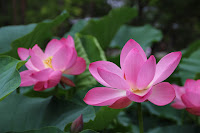This trip was in July 2014 during the Marine Day weekend. We caught the 9 am bullet train,Tohoku Shinkansen, from Tokyo to Sendai and then used a rented car.
One tip: If you travel using JR (Japan Railway Company) and a rent-a-car, there is a discount package offered called, Trenta-kun (no English site), where you get discount off your fees on JR fares. There are some restrictions in using this package like using more than 210 km of Shinkansen.
We arrived at Hiraizumi around 12 half.
Motsu-ji is a remain of an ancient huge temple, larger than Chuson-ji, back in the beginning of 12th century where Fujiwara's ruled around here. Most of the buildings were lost by fires and now remains a jodo style garden.
Jodo means heaven and this garden was an attempt to create a buddhism heaven in this world. Ponds, bridges over them, a gorgeous buidling in center and lotus flowers are the features of this style gargen was popular in Heian peirod. I often hear in european cathedrals that they are built as a heaven in this world. It's a same here. It reminds me of how difficult life is for those people living at that time.
It was a good season for lotus. Next time I may want to this vist this place in the 4th Sunday in May when they hold a annual Gokusui-no-en event. Gokusui-no-en is an activity for Heian nobles which they try to create a poem before a cup floating on a stream passes before you. It will be interesting to see moder people in Heian outfit trying to squeeze out good poems.
It was raining when we arrived. Just like "an early summer rain, leaving only Hikari-do, without a shower" a haiku by Matsuo Basho, a famous poet in Edo period.
Basho's footprints and his poems tying into the various places, remain everywhere around Japan. There is even an academic debate that he might have been a ninja, claiming that it was not for ninga he could not have traveled that distance in such a short period. I like this theory, worth a laugh, but I tend to think he resembles more a famous travel blogger. He never misses a great place to visit and leaving behind a good haiku which attracts people.
 Matsuo Basho, a famous travel blogger
Matsuo Basho, a famous travel blogger
Chuson-ji is famous for the Golden Hall, Konjiki-do or a way Basho puts it Hikari-do. This is the reason why Marco Polo misunderstood Japan as a country of gold and Chirstopher Columbus ended up sailing out to the Atlantic.
 On the way to the Golden Hall
On the way to the Golden Hall
My impression on the Golden Hall is somewhat small, maybe I was also the one misrepresended by Marco Polo, but still it was beautiful. By the way in this Golden Hall, the 4 generations of Fujiwaras were laid in peace, mummified and still are (!).
If you go all the way to the far end of Chuson-ji, you can find a cafe, Kanzan-tei. It has some noodles, pastas and desserts. I tried wagashi, a Japanese sweet which matches good with green tea. One of the Japanese cultural feature is to enjoy the seasons and this is one example of trying to feel the season in what you eat.
 Hotaru or a dragon fly
Hotaru or a dragon fly
3. Bettou Takkoku Seikou-ji
This temple is small and not that famous compared to Chuson-ji or Motsu-ji but still interesting to see the temple poised on the rocky hill. This temple was built by Sakanoueno Tamuramaro, a 9th century shogun designated by the emperor who sat in Kyoto at that time to conquer the barbarians in the North. He defeated them and to thank the war god, Bishamon-ten or Vaiśravaṇa in sanscrit, he sponsored to build this temple.
This temple was intended to take on Kiyomizu-temple in Kyoto. Yes, that Kiyomizu temple with big stage leaning out.
 Enclaved Budda on the rocky hill
Enclaved Budda on the rocky hill
Bettou Takkoku Seikouji (Takkoku Bishamondou)
Address: 16 Aza Kitazawa, Hiraizumi, Hiraizumi-cho, Nishiiwai-gun, Iwate
Tel: 0191-46-4931
Note: 10 minutes from JR Hiraizumi Station
4. Shiwahiko Shrine and Shiogama Shrine
On our way back to Sendai, we stopped by at Shiogama. Shiogama means in plain Japanese "salt cauldron" and also a nickname of the god, Shiotsuchiooji or Shiogama-sama who is enshrined. Shiogama-sama is a god of salt industry and fishery. Shiwahiko is another god who rests just next to Shiogama Shirine, who was worshipped by the locals back around 4th to 6th century and this place was at the edge of Yamato emperor's realm so this god was named "shiwa" which means edge in old Japanese.
These shrines are at the top of the hill where you can have a good view of Shiogama bay. I heard that when the East Japan Great Earthquake hit Tohoku they could see Tsunami coming down from this place. It is interesting, generally speaking, old shrines are placed where is it most stable and tolerant on disasters in surrounding neighborhood.
 Imagine tsunami coming down the bay
Imagine tsunami coming down the bay
Shiwahiko Shrine/Shiogama Shrine
Address: 1-1 Ichimoriyama, Shiogama-shi, Miyagi
Tel: 022-367-1611
Shiogama is a fishing town, why not enjoy sushi, so we went to Sushi-tetsu (not in English but take a look at those sushi!). I especially loved tuna or maguro. One of my lifetime best maguro-sushi so far. It has a branch in Miyagi station as well.
Sushi Tetsu
Address: 2-22 Kaigandori, Shiogama-shi, Miyagi
Tel: 022-362-3261
I really enjoyed this trip and hope you will too!

























